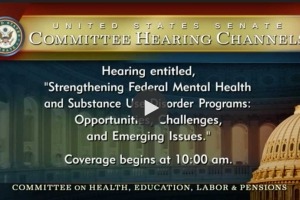Chairman Cornyn, Co-Chairwoman Feinstein and members of the Caucus on International Narcotics Control, we appreciate the opportunity to share the content of the recent Surgeon General’s Advisory on Marijuana Use and the Developing Brain with you, and to join national experts to discuss this complex issue that demands our attention and action. Recent increases in access to marijuana and in its potency, along with misperceptions of its safety, endanger our most precious resource, our nation’s youth.
Background
Marijuana, or cannabis, is the most commonly used illicit drug in the United States. In 2018, 43.5 million people reported using marijuana in the past year.1 Marijuana acts by binding to cannabinoid receptors in the brain to produce a variety of effects, including euphoria, intoxication, and memory and motor impairments. These cannabinoid receptors are part of an extensive endocannabinoid system that regulates a wide range of functions, including brain development.
The endocannabinoid system appears relatively early during fetal development. As the fetal brain grows, this system influences how brain cells develop and connect with one another, and it plays a major role in the formation of brain circuits including those important for decision making, mood, and responding to stress.2 Not surprisingly, animal studies have shown that in utero exposure to marijuana can interfere with the proper development and regulation of brain circuitry. Moreover, the endocannabinoid system is a critical regulator of the neuronal hardwiring that translates experience throughout the teen years and young adulthood into mature brain architecture. This helps explain why the developing brain is particularly vulnerable to chronic exposure to delta-9-tetrahydrocannabinol (THC), the component of marijuana responsible for euphoria, intoxication, and addiction.
Marijuana and its related products are widely available in multiple forms, with varying concentrations of constituent chemicals, the most salient of which are known collectively as “cannabinoids”. In addition to varying levels of THC, marijuana also contains cannabidiol (CBD). While pure CBD is not intoxicating and does not lead to addiction, its long-term effects are largely unknown. In addition to THC and CBD, the marijuana plant also contains hundreds of other cannabinoid and non-cannabinoid components, many of which have not been studied extensively.
Marijuana has changed over time; the marijuana available today is much more potent than what was available in the past. The THC concentration in commonly cultivated marijuana plants increased three-fold between 1995 and 2014 (4 percent and 12 percent, respectively),4 and marijuana available in dispensaries in some states has average concentrations of THC between 17.7 percent and 23.2 percent.5 Concentrated products, commonly known as dabs or waxes, are widely available to recreational users today and may contain between 23.7 percent and 75.9 percent THC.6
The risks of physical dependence, addiction, and other negative consequences increase with frequent use, exposure to high concentrations of THC7 and with younger age of initiation. Higher doses of THC are more likely to produce anxiety, agitation, paranoia, and psychosis.8 Use of edible marijuana can increase the risk of unintentional overdose due to its lengthy absorption time and delayed effect, often prompting the user to take a second dose. Edibles, which may have the appearance of desserts or snacks, are also increasingly a cause of accidental ingestion by children9 and adolescents.10 In addition, chronic users of marijuana with a high THC content are at risk for developing a condition known as cannabinoid hyperemesis syndrome, which is marked by severe cycles of nausea and vomiting.11 The increase in the THC content of marijuana, combined with the growing availability of loosely regulated cannabis products, has led to a worrisome upward trend in the rate of calls to poison control centers and emergency department visits over the past decade.
Surgeon General’s Advisory on Marijuana Use and the Developing Brain
On August 29, 2019, the Surgeon General’s Advisory on Marijuana Use and the Developing Brain was issued to emphasize the importance of protecting our Nation from the health risks of marijuana use in adolescence and during pregnancy. This advisory is intended to raise awareness of the known and potential harms that the increasing availability of highly-potent marijuana in multiple, concentrated forms poses to the developing brain of youth and young adults who consume it. These harms can be long-lasting and costly to individuals and to our society, impacting mental health and educational achievement and raising the risks of addiction and other psychiatric disorders. In addition to the health risks posed by marijuana use, the sale or possession of marijuana remains illegal under federal law, notwithstanding some state laws to the contrary.
Marijuana Use during Pregnancy
Pregnant women use marijuana more than any other illicit drug. In a national survey, marijuana use in the past month among pregnant women doubled (3.4 percent to 7 percent) between 2002 and 201712, although this trend may be starting to reverse based on the most recent data reported in the National Survey on Drug Use and Health. In a study conducted in a large health system in California, marijuana use rose by 69 percent (4.2 percent to 7.1 percent) between 2009 and 2016 among pregnant women, with the highest rates of use occurring among pregnant women under the age of 25. These researchers found that 22 percent of pregnant girls under the age of 18 and 19 percent of pregnant women ages 18-24 used marijuana in 2016.13 Alarmingly, many retail dispensaries recommended marijuana to pregnant women for morning sickness.14
Since the THC in marijuana crosses the placenta, it may disrupt the important role the endocannabinoid system plays in fetal brain development and in maintaining a healthy pregnancy.2 Moreover, the placenta itself has cannabinoid receptors, which might contribute to restricted fetal growth with cannabis use during pregnancy34. Indeed, studies have shown that marijuana use in pregnancy is associated with adverse outcomes, including lower birth weight and16 and preterm delivery.35 For example, The Colorado Pregnancy Risk Assessment Monitoring System reported that maternal marijuana use was associated with a 50 percent increased risk of low birth weight regardless of maternal age, race, ethnicity, education, and tobacco use.16
The American College of Obstetricians and Gynecologists holds that “[w]omen who are pregnant or contemplating pregnancy should be encouraged to discontinue marijuana use. Women reporting marijuana use should be counseled about concerns regarding potential adverse health consequences of continued use during pregnancy.”17 In a 2018 clinical guidance statement, the American Academy of Pediatrics recommended that health professionals, “…advise all adolescents and young women that if they become pregnant, marijuana should not be used during pregnancy”18.
While cannabis use during pregnancy is associated with increased risk of adverse birth outcomes, later effects on the child due to exposure to THC through breastmilk are still unclear. This is in part due to challenges disentangling the long-term effects associated with marijuana exposure in utero versus during nursing. Although additional research is needed in this area, there is ample reason for caution, as THC has been detected in breastmilk for up to six days after the last recorded use. Additionally, marijuana smoke contains many of the same harmful components as tobacco smoke;22 no one should smoke marijuana or tobacco around a baby.
Marijuana Use during Adolescence
Each day in 2018, 3700 adolescents aged 12 to 17 became new users of marijuana.1 Although marijuana use declined among 8th graders and remains unchanged among 10th and 12th graders compared to five years ago, high school students’ perception of the harm from regular marijuana use has been steadily declining over the last decade.24 In 2018, only about a third (34.9 percent) of adolescents aged 12 to 17 perceived great risk from weekly marijuana use.1 During this same period, a number of states legalized adult and/or so-called medicinal use of marijuana, though it remains illegal under federal law. Importantly, medical marijuana laws may allow for use at a younger age than adult recreational laws. The legalization movement may be impacting youth perception of harm from marijuana.
The human brain continues to develop from before birth into the mid-20s and is vulnerable to the effects of addictive substances.25, 26 Frequent marijuana use during adolescence is associated with structural and functional changes in areas of the brain involved in attention, memory, decision-making, and motivation, and in deficits in attention and memory.27 Marijuana can also impair learning in adolescents. Chronic use is linked to declines in IQ and school performance, which may jeopardize professional and social achievements, and life satisfaction.29 Regular use of marijuana in adolescence is linked to increased rates of school absence and drop-out, as well as suicide attempts.29
Marijuana use is also linked to both overall risk for and early onset of psychotic disorders, such as schizophrenia. The risk for psychotic disorders increases with frequency of use, potency of the marijuana product, and younger age of initiation.30 Adolescent marijuana use is also associated with other substance use.31,32 In 2017, teens 12-17 reporting frequent use of marijuana showed a 130 percent greater likelihood of misusing opioids.23 2018 data from 8th, 10th, and 12th graders show that a third reported lifetime cannabis use and almost a quarter reported lifetime use of concentrated products. Adolescents using concentrates show higher rates of other substance use and risk factors for substance use-related problems.33 Marijuana’s increasingly widespread availability in multiple and highly potent forms, coupled with a false and dangerous perception of safety among youth, merits a nationwide call to action.
Research Supported by the National Institutes of Health’s (NIH) National Institute on Drug Abuse (NIDA)
NIH supports a broad range of research aimed at understanding the public health effects of marijuana use at all stages of life. NIDA’s portfolio includes research on the pharmacology of THC and other cannabinoids in the marijuana plant; the molecular mechanisms underlying the effect of marijuana use on the brain, including its development; epidemiologic studies to elucidate the prevalence and patterns of marijuana use; research to understand the brain changes associated with cannabis addiction and other adverse effects such as amotivation, an unwillingness to participate in normal social situations; research on the potentially beneficial effects of marijuana and its constituent compounds; applied research aimed at preventing and treating cannabis misuse and addiction; as well as research aimed at understanding how marijuana policies affect public health.
There is still much we do not know about the impact of marijuana exposure during the vulnerable periods of adolescence and pregnancy; therefore, these remain key areas of focus for NIDA. Two current studies with great potential to advance knowledge in these areas are the Adolescent Brain Cognitive Development (ABCD) study and the HEALthy Brain and Child Development (HBCD) study. ABCD, the largest long-term study of brain development and child health in the United States, is expected to yield an unprecedented amount of information about normal brain development and how it is affected by substance use—including use of marijuana—and other childhood experiences. The ABCD study has recruited over 11,000 children ages 9-10 and is following them into early adulthood. By integrating structural and functional brain imaging with genetic and biological markers, along with psychological, behavioral, and other health assessments, ABCD will increase our understanding of the many factors that can enhance or disrupt a young person’s life trajectory. Complementing ABCD is the HBCD Study, which is currently in its planning phase. HBCD would establish a large cohort of pregnant women and assess maternal and child outcomes over the course of at least 10 years. In parallel to the ABCD study, findings from this cohort will help researchers understand both normal childhood brain development as well as the long-term impact of prenatal and postnatal drug and environmental exposures.
Key Messages and Critical Actions
No amount of marijuana use during pregnancy or during youth when the brain is under development is known to be safe. Until and unless more is known about the long-term impact, the safest choice for pregnant women and youth is not to use marijuana. Although women generally tend to limit drug use during pregnancy, education efforts on marijuana’s adverse effects during pregnancy should be expanded and improved. Pregnant women and youth--and those who love them--need the facts and resources to support healthy decisions. It is critical to educate women and youth, as well as family members, school officials, state and local leaders, and health professionals, about the risks of marijuana.
Science-based messaging campaigns and targeted prevention programming are urgently needed to ensure that risks are clearly communicated and amplified by local, state, and national organizations. Clinicians can help by asking about marijuana use, and by informing pregnant women, new mothers, young people, and those vulnerable to psychotic disorders of the risks associated with marijuana use. Clinicians can also prescribe safe, effective, and FDA-approved treatments for nausea, depression, and pain during pregnancy.
What we know now about the impact of marijuana exposure during adolescence, as well as during prenatal development is enough to warrant concern and action. Still, further research is needed to understand the full effects of marijuana exposure on biological, cognitive, and social development, especially the mid- and long-term consequences of prenatal and youth exposures. The wide and ever-increasing array of cannabis products used both recreationally and for therapeutic purposes also raise significant public health concerns, particularly when used by young people and pregnant women. Additional research aimed at evaluating the health effects of these products is critical.
Thank you for the opportunity to share this summary of the current trends in marijuana use among youth and pregnant women; the state of the evidence regarding the harms to developing brains; and the steps we can take together to understand more about and to mitigate those harms in order to protect our youth, the future of our nation. I am happy to answer any questions you may have.
References:
- Substance Abuse and Mental Health Services Administration. (2019). Key substance use and mental health indicators in the United States: Results from the 2018 National Survey on Drug Use and Health (HHS Publication No. PEP19-5068, NSDUH Series H-54). Rockville, MD: Center for Behavioral Health Statistics and Quality, Substance Abuse and Mental Health Services Administration. Retrieved from https://www.samhsa.gov/data/
- Brents L. K. (2016). Marijuana, the Endocannabinoid System and the Female Reproductive System. The Yale journal of biology and medicine, 89(2), 175–191.
- National Center for Chronic Disease Prevention and Health Promotions, Centers for Disease Control and Prevention. Marijuana and Public Health: How is marijuana used? https://www.cdc.gov/marijuana/faqs.htm.
- Elsohly, M. A., Mehmedic, Z., Foster, S. (2016). Changes in Cannabis Potency Over the Last 2 Decades (1995-2014): Analysis of Current Data in the United States. Biological Psychiatry, 79(7), 613-619. doi:10.1016/j.biopsych.2016.01.004.
- Jikomes, N., & Zoorob, M. (2018). The Cannabinoid Content of Legal Cannabis in Washington State Varies Systematically Across Testing Facilities and Popular Consumer Products. Scientific reports, 8(1), 4519. doi:10.1038/s41598-018-22755-2
- Alzghari, S. K., Fung, V., Rickner, S. S., Chacko, L., & Fleming, S. W. (2017). To Dab or Not to Dab: Rising Concerns Regarding the Toxicity of Cannabis Concentrates. Cureus, 9(9), e1676. doi:10.7759/cureus.1676.
- Freeman, T. P., & Winstock, A. R. (2015). Examining the profile of high-potency cannabis and its association with severity of cannabis dependence. Psychological medicine, 45(15), 3181–3189. doi:10.1017/S0033291715001178
- Volkow N.D., Baler R.D., Compton W.M., Weiss S.R.B. Adverse Health Effects of Marijuana Use N Engl J Med. 2014 June 5; 370(23): 2219–2227. doi:10.1056/NEJMra1402309.
- Richards, J.R., Smith N.E., Moulin, A.K. Unintentional Cannabis Ingestion in Children: A Systematic Review. J Pediatr 2017; 190:142-52.
- Cao, D., Sahaphume, S., Bronstein, A.C., Hoyte, C.O., Characterization of edible marijuana product exposures reported to the United States poison centers. Clinical Toxicology, 54:9, 840-846, DOI: 10:1080/15563650.2016.1209761
- Galli, J.A., Sawaya, R.A., Friedenberg, F.K. Cannabinoid Hyperemesis Syndrome. Curr Drug Abuse Rev. 2011 Dec; 4(4): 241–249.
- Volkow N.D., Han B., Compton W.M., McCance-Katz E.F. Self-reported Medical and Non-medical Cannabis Use Among Pregnant Women in the United States. JAMA. 2019 doi:10.1001/jama.2019.7982
- Young-Wolff KC, Tucker L, Alexeeff S, et al. Trends in Self-reported and Biochemically Tested Marijuana Use Among Pregnant Females in California From 2009-2016. JAMA. 2017;318(24):2490–2491. doi:10.1001/jama.2017.17225.
- Dickson, B. (2018). Recommendations From Cannabis Dispensaries About First-Trimester Cannabis Use. Obstetrics & Gynecology. 2018; 0029-7844. doi:10.1097/AOG.0000000000002619.
- National Academies of Sciences, Engineering, and Medicine. 2017. The health effects of cannabis and cannabinoids: Current state of evidence and recommendations for research. Washington, DC: The National Academies Press.
- Crume et al: Cannabis use during the perinatal period in a state with legalized recreational and medical marijuana: the association between maternal characteristics, breastfeeding patterns, and neonatal outcomes. J Pediatr. 2018;197:90-96.
- American College of Obstetricians and Gynecologists: Marijuana use during pregnancy and lactation. Committee Opinion No. 722. Obstet Gynecol. 2017;130(4):e205-e209.
- Ryan et al: Marijuana use during pregnancy and breastfeeding: implications for neonatal and childhood outcomes. Pediatrics. 2018; 142(3):,e20181889.
- Bertrand, K. A., Hanan, N. J., Honerkamp-Smith, G., Best, B. M., & Chambers, C. D. (2018). Marijuana Use by Breastfeeding Mothers and Cannabinoid Concentrations in Breast Milk. Pediatrics, 142(3). doi:10.1542/peds.2018-1076.
- Metz TD, Stickrath EH: Marijuana use in pregnancy and lactation: a review of the evidence. Am J Obstet Gynecol. 2015;213(6):761-778.
- Effects while pregnant or breastfeeding. (2017, March 02). Retrieved from colorado.gov/pacific/marijuana/effects-while-pregnant-or-breastfeeding.
- Moir, D., et al., A comparison of mainstream and sidestream marijuana and tobacco cigarette smoke produced under two machine smoking conditions. Chem Res Toxicol 21: 494-502. (2008).
- Substance Abuse and Mental Health Services Administration. (2018). Key Substance Use and Mental Health Indicators in the United States: Results from the 2017 National Survey on Drug Use and Health (HHS Publication No. SMA 18-5068, NSDUH Series H-53). Rockville, MD: Center for Behavioral Health Statistics and Quality, Substance Abuse and Mental Health Services Administration
- Johnston, L. D., Miech, R. A., O'Malley, P. M., Bachman, J. G., Schulenberg, J. E., & Patrick, M. E. (2019). Monitoring the Future national survey results on drug use, 1975-2018: Overview, key findings on adolescent drug use. Ann Arbor: Institute for Social Research, The University of Michigan, 119 pp.
- Pujol, J., Vendrell, P., Junqué, C., Martí-Vilalta, J. L., & Capdevila, A. (1993). When does human brain development end? Evidence of corpus callosum growth up to adulthood. Annals of Neurology, 34(1), 71-75. doi:10.1002/ana.410340113.
- Levine, A., Clemenza, K., Rynn, M., & Lieberman, J. (2017). Evidence for the Risks and Consequences of Adolescent Cannabis Exposure. Journal of the American Academy of Child & Adolescent Psychiatry, 56(3), 214-225. doi:10.1016/j.jaac.2016.12.014.
- Meruelo AD, Castro N, Cota CI, Tapert SF. Cannabis and alcohol use, and the developing brain. Behav Brain Res. 2017;325(Pt A):44–50. doi:10.1016/j.bbr.2017.02.025.
- Meier M.H., Caspi A., Ambler A., et. al. Persistent cannabis users show neuropsychological decline from childhood to midlife. Proc Natl Acad Sci USA., 2012. Oct 2; 109(40) E2657-64 doi 10.1073/pnas. 1206820109. Epub 2012 Aug 27
- Silins, E., Horwood, L. J., & Patton, G. C. (2014). Young adult sequelae of adolescent cannabis use: An integrative analysis. The Lancet Psychiatry, 1(4), 286-293. doi:10.1016/s2215-0366(14)70307-4.
- Di Forti, M., Quattrone, D., & Freeman, T. (2019). The contribution of cannabis use to variation in the incidence of psychotic disorder across Europe (EU-GEI): A multicenter case-control study. The Lancet Psychiatry, 6(5), 427-436. doi:10.1016/S2215-0366(19)30048-3.
- Lopez-Quintero C., Perez de los Cabos J., Hasin D.S. (2011). Probability and predictors of transition from first use to dependence on nicotine, alcohol, cannabis, and cocaine: results of the National Epidemiologic Survey on Alcohol and Related Conditions (NESARC). Drug Alcohol Dependence. 115(1-2):120-130.
- Jones, C. M., & McCance-Katz, E.F. (2019). Relationship Between Recency and Frequency of Youth Cannabis Use on Other Substance Use. Journal of Adolescent Health, 64(3), 411-413. doi:10.1016/j.jadohealth.2018.09.017.
- Meier M.H., Docherty M., Leischow S.J., Grimm K.J., Pardini D. Cannabis Concentrate Use in Adolescents. Pediatrics. 2019 Sep;144(3). pii: e20190338. doi: 10.1542/peds.2019-0338.
- Maia J., Midão L., Cunha S.C., Almada M., Fonseca B.M., Braga J., Gonçalves D., Teixeira N., Correia-da-Silva G. Effects of cannabis tetrahydrocannabinol on endocannabinoid homeostasis in human placenta. Arch Toxicol. 2019 Mar;93(3):649-658. doi: 10.1007/s00204-019-02389-7. Epub 2019 Jan 18.
- Petrangelo A., Czuzoj-Shulman N., Balayla J., Abenhaim H.A. Cannabis Abuse or Dependence During Pregnancy: A Population-Based Cohort Study on 12 Million Births. J Obstet Gynaecol Can. 2019 May;41(5):623-630. doi: 10.1016/j.jogc.2018.09.009. Epub 2018 Nov 15.



